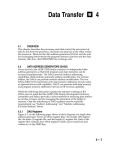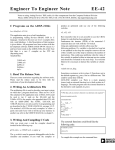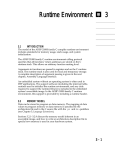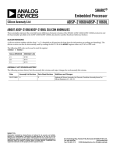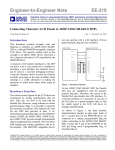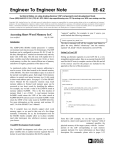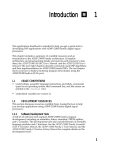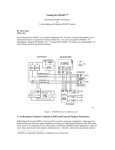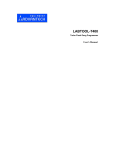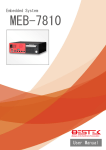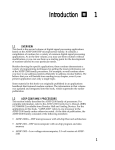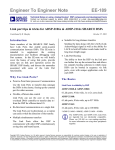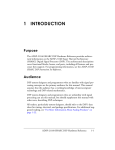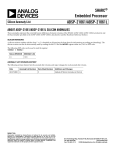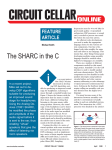Download 4 Assembly Language Interface
Transcript
Assembly Language Interface
4.1
4
INTRODUCTION
This chapter describes how to interface assembly language code with C
code.
You must be familiar with ADSP-21000 family assembly language and the C
runtime model to make best use of this chapter. See the ADSP-2106x SHARC
User’s Manual, ADSP-21020 User’s Manual, and the previous chapter of this
manual.
There are several ways to incorporate assembly language statements into a
program that contains code written in C:
• Write assembly language functions that are C-callable
• Use assembly language statements within a C function (by using the
asm() in-line assembly construct)
• Associate C variables with assembly-language symbols
Throughout this chapter there are references to asm_sprt.h , a header file
containing macros to help you write assembly language implementations of
C functions. These macros are summarized at the end of this chapter. This
header file is found in $ADI_DSP\21K\INCLUDE. If you use these macros,
any file including the asm_sprt.h header file must be processed by the
G21K compiler, and not by the ASM21K assembler only.
4–1
4 Assembly Language Interface
4.2
ASSEMBLY LANGUAGE FUNCTIONS
Assembly language functions may be linked with C functions. They
are normally placed in files with the .s or .asm suffix. There are
several issues involved in writing a C-callable assembly language
function:
Using registers
Retrieving parameters
Calling other functions
Function entry
Function exit
Naming conventions for assembly-language symbols
4.2.1
Using Registers
There are some points to consider when using ADSP-21xxx registers in
assembly language programming under the C runtime environment:
• Most registers of the processor are available to the assembly language
programmer.
• Some registers have special purposes and must be used only for those
purposes. For example, some registers need to contain fixed values for
the compiler.
• If registers are used in assembly language, rules must be followed
when the contents of registers are saved and restored.
• We recommend using the macros in asm_sprt.h for saving
registers to the stack and restoring them from it.
4.2.1.1 Special Purpose Registers
Two registers, called the stack pointer and frame pointer, are used to
manipulate the C runtime stack. The C runtime stack is used to store
automatic variables, pass parameters, store function return address,
and store the intermediate results of computations.
The stack pointer, register I7, points to the top of the stack. The top of
the stack is the next empty location on the stack. The stack grows
towards address 0. Thus, if a value is “pushed” on the stack, it is
placed at the location pointed to by the stack pointer and the stack
pointer is decremented.
4–2
The frame pointer, register I6, points to the start of the frame for the
current function.
Assembly Language Interface 4
4.2.1.2 Fixed Value Registers
M Registers
Several M registers are used to hold fixed values. The run-time header,
which executes on processor startup, sets these registers to their
designated values and calls main() . The compiler assumes that these
registers contain their designated values. Assembly language functions
must not change these registers, but may rely on their containing the
following values:
DAG1 Register
M5
M6
M7
DAG2 Register
M13
M14
M15
Value
0
1
-1
L Registers
The compiler requires that the L registers contain zeros. All the L
registers, except for L6 and L7, may be set by an assembly language
function to any value. However,they must be reset to 0 before the
assembly language function returns.
4.2.1.3 Saving & Restoring Registers
The compiler makes assumptions about how functions treat registers.
If the compiler knows that a function does not destroy the contents of a
register, the compiler may keep “live” data in that register when the
function call is made. However, if the compiler expects that a
subroutine destroys the contents of a register, the compiler attempts to
avoid keeping useful information in that register when a function call
is made. If the register contains “live” data, then the compiler must
save a copy of that data before the function call and restore that copy
to the register after the function call.
There are two classes of registers:
• Compiler registers are registers that the compiler assumes are
preserved across function calls.
• Scratch registers are registers that the compiler assumes are not
preserved across function calls.
Note: It is not necessary that the called function actually overwrite
scratch registers; to be safe, the compiler assumes that they are
overwritten.
4–3
4 Assembly Language Interface
Compiler Registers
Scratch
R3, R5, R6, R7, R9, R10,
R11, R13, R14, R15
R0, R1, R2, R4,
R8, R12
Index Registers
I0, I1, I2, I3, I5, I8, I9, I10,
I11, I14, I15
I4, I12
Modify Registers
M0, M1, M2, M3, M8,
M9, M10, M11
M4, M12
Other Registers
MRF, MRB, MODE1,
MODE2, USTAT1,
USTAT2
Registers
Data Registers
Here are some rules about saving and restoring registers:
1. Registers may be saved by pushing them onto the stack. This is done
as follows:
dm(i7,m7)=r3;
This instruction places register R3 onto the stack and decrements the
stack pointer.
Note: Register M7 is fixed at -1.
2. A value may be popped off the stack by reading it, and then adjusting
the stack pointer. The following instructions might be used:
r3=dm(1,i7);
modify(i7,1);
3. The stack pointer must always point to the next empty location on the
stack.
Note: The one exception to this rule is during the delay branch slots of
the jump at the end of a function. The hardware of the ADSP-210xx
locks out interrupts during these cycles, so you don’t need to worry
about the stack being corrupted.
4–4
Assembly Language Interface 4
As a negative example, the following code is not recommended
because an interrupt could corrupt the stack.
modify(i7,1); /* NOT recommended */
r3=dm(0,i7); /* NOT recommended */
If an interrupt occurred after the modify but before the read the stack
would be pointing at valid data. The interrupt service routine would
write over this data.
4. At the beginning of an assembly language function, all compiler
registers that are used in the function must be saved. At the end of an
assembly language function, all those that were saved must be
restored.
5. Before a function call, all scratch registers that contain “live” data must
be saved. After a function call, all those scratch registers that were
saved must be restored.
4.2.1.4 Macros For Stack Access
The header file asm_sprt.h includes many macros useful for
interfacing C to assembly language. For example, the puts() macro
does a push:
puts=r7;
This instruction pushes r7 onto the stack. Similarly the gets()
macro reads off the stack. For example, to read the most recently
pushed value into register r9 , use this code:
r9=gets(1);
You can use the restore_reg macro in conjunction with the
save_reg macro to save and restore all register file registers (R0R15). The macros are found in asm_sprt.h . Use them as a templates
for constructing code for performing register saves and restores.
4–5
4 Assembly Language Interface
4.2.1.5 Secondary Register Set
The register file of ADSP-21000 family processors has a complete
secondary set of the primary registers. The C runtime environment
model does not use any of the secondary registers. Therefore, you may
use the secondary register set in assembly language freely. The C
runtime environment is not corrupted by using the secondary register
set. When you switch back to using the primary register set, the
primary registers are as you left them.
4.2.2
Retrieving Parameters
This section describes how parameters to C functions are accessed.
4.2.2.1 Where The Parameters Are
In the C environment, arguments are passed to functions by placing
them in registers or on the stack, according to the following rules:
1. Up to three arguments may be passed in registers.
The first argument to be passed in a register is placed in R4 .
The second argument to be passed in a register is placed in R8 .
The third argument to be passed in a register is placed in R12 .
2. Once one argument has been passed on the stack, all remaining
arguments (those to the right) are on the stack.
3. All values wider than 32 bits are passed on the stack. These include
variables of type double and complex , and structures passed by
value.
Whenever a double or float is placed on the stack, the most
significant word falls at the lower address, the least significant word
at the higher address.
Whenever a complex is placed on the stack, the real part is put at
the lower address, the imaginary part is put at the higher address.
4. The last named argument in a function call with a variable number of
arguments is passed on the stack.
4–6
Assembly Language Interface 4
4.2.2.2 Parameter Passing Examples
Consider the following function prototype example:
foo(int a, float b, char c, float d);
The first three arguments, a , b , and c are passed in registers R4 ,
R8 , and R12 , respectively. The fourth argument d is passed on the
stack.
This next example illustrates the effects of passing doubles.
bar(int a, double b, char c, float d);
The first argument a is passed in R4 . Since the second argument b
is a multi-word argument, it is passed on the stack. As a result, the
remaining arguments, c and d , are passed on the stack.
The following illustrates the effects of variable arguments on
parameter passing:
test(float a, int b, char c,...);
Here, the first two arguments, a and b , are passed in registers R4
and R8 . Since c is the last named argument, it is passed on the stack,
as are all remaining variable arguments.
4.2.2.3 Accessing Stack Parameters
When arguments are placed on the stack, they are pushed on from
right to left. The right-most argument is at a higher address than the
left-most argument passed on the stack.
The following example shows how to access parameters passed
on the stack:
test( int a, char b, float c, int d, int e, long f);
Parameters a , b , and c are passed in registers because they are singleword parameters. The remaining parameters, d, e, and f , are passed
on the stack.
4–7
4 Assembly Language Interface
All parameters passed on the stack are accessed relative to the stack pointer,
register I6 . The first parameter passed on the stack, d , is at address sp + 1 .
To access it, you could use this assembly language statement,
r3=dm(1,i6);
The second parameter passed on the stack, e , is at sp + 2 and can be accessed
by the statement
r3=dm(2,i6);
The third parameter passed on the stack, f , is a long that has its most
significant word at sp + 3 and its least significant word at the top of the stack.
f(MSW) can be accessed by the statement
r3=dm(3,i6);
4.2.2.4 Macros For Parameters
The asm_sprt.h file includes a macro, reads() , for reading parameters
off the stack. For example, to read the second stack-passed parameter into
register R5, you could use this statement:
r5=reads(2);.
4.2.3
Calling Functions
You must follow the calling protocol to call a function in the C environment.
The macros in asm_sprt.h are provided to make this easier.
4.2.3.1 The Calling Protocol
Calling a function in a C environment involves several steps:
1. The arguments to the function must be passed.
2. The return address must be stored on the stack. The return address must
be the address immediately preceding the address where execution is to
resume.
4–8
3. A delayed branch jump to the function call must be made. A jump is used,
instead of a call, because the return is handled by another, indirect jump.
Jumps are preferable to calls because calls are limited by the on-chip PC
stack depth. Jumps have no nesting limit, as they allow saving the return
address in external memory. The delayed branch form of the jump
instruction is used so that the frame pointer adjustment may take place in
the two delayed branch slots, which cannot be interrupted.
Assembly Language Interface 4
4. The frame pointer must be adjusted. The current function’s frame pointer,
I6 , is written into R2 , and then the the current stack pointer, I7 , is written
into I6 to create the called function’s frame pointer.
5. When the function returns, it may be necessary to adjust the stack pointer to
remove the function’s arguments from the stack. This is done by adding a
constant, the number of stack positions used by arguments, to the stack
pointer.
The calling protocol is different for calling C functions from assembly language
routines. This does not affect C-callable assembly routines. The calling
sequences for the ADSP-21020 and ADSP-2106x are different.
Use the following code sequence to call a function (foo()) for the ADSP-21020:
R2 = I6;
I6 = I7;
JUMP (PC, _foo) (DB);
DM(I7, M7) = R2;
DM(I7, M7) = PC;
/*
/*
/*
/*
/*
Hold
Swap
JUMP
Save
Save
old frame
stack and frame
to foo()
old frame
return address
*/
*/
*/
*/
*/
Use the following code sequence to call a function (foo()) for the ADSP-2106x:
CJUMP _foo (DB);
DM(I7, M7) = R2;
DM(I7, M7) = PC;
/* JUMP to foo(), swap
/* Save old frame
/* Save return address
*/
*/
*/
The old frame and return address are saved by the caller, so the called
prologue is composed only of register saves.
The epilogue is:
I12 = DM (-1, I6);
/* Fetch return address
*/
followed by any register restore operations. The compiler reads the return
address before restoring other registers.
The last instructions of an ADSP-21020 routine are:
JUMP (M14, I12) (DB); /* Return to caller
I7 = I6;
/* Clean stack
I6 = DM (0, I16);
/* Restore old frame
*/
*/
*/
4–9
4 Assembly Language Interface
The last instructions of an ADSP-2106x routine are:
JUMP (M14, I12) (DB); /* Return to caller
RFRAME;
/* Restore stack, frame
NOP;
/* Used for useful op!
*/
*/
*/
The compiler will replace the NOP with a useful instruction (such as a
register restore operation) whenever possible.
4.2.3.2 Macros For Calling A Function
The asm_sprt.h file includes macros to perform all the necessary
steps for calling C functions.
To push a value on the stack, use the puts() macro. For example to
push the value of register R3 onto the stack, you would use this
statement:
puts=R3;
To call a function use the ccall() macro. For example, to call
foo() ,
ccall(_foo);
The ccall() macro pushes the return address onto the stack,
performs the frame pointer adjustment, and jumps to the other
function.
The alter() macro can be used to remove values from the stack.
For example, to remove the last three values from the stack, you could
use this statement:
alter(3);
4.2.4
Function Entry
You must follow the C runtime environment calling protocol when
entering a function. The macros in asm_sprt.h are provided to
make this easier.
4 – 10
Assembly Language Interface 4
4.2.4.1 What Is Needed On Function Entry
On function entry, the called function must save information necessary
to return to the calling context.
1. The calling function’s frame pointer was loaded into register R2 by
the calling function (see the previous section). The old frame pointer
must be saved to the stack so that it can be used later.
2. The calling function pushes the return address onto the stack. This
value must be saved so that it can be used later.
4.2.4.2 Macros For Entry
The entry macro, found in the header file asm_sprt.h , saves both
the calling function’s frame pointer and the return address.
4.2.5 Function Exit
4.2.5.1 What Is Needed On Function Exit
Several operations must be performed at the end of an assembly
language function.
1. The return value must be placed in the appropriate register(s). If a
single word value is being returned, it must be returned in register
R0. If a two word value is being returned, it must be returned in
registers R0 and R1.
If a double is returned, R0 contains the MSW (Most Significant
Word) and R1 contains the LSW (Least Significant Word).
If a complex is returned, R0 contains the real part and R1
contains the imaginary part.
2. The values that occupied compiler registers that were saved at the
top of the function must be restored to their original locations. They
may be read off the stack, relative to the frame pointer.
3. The calling function’s stack pointer must be restored. Before
transferring control, the calling function copied its stack pointer, I7
, to the frame pointer, I6 . To restore the calling function’s stack
pointer, copy the frame pointer, I6 , to the stack pointer, I7 .
4 – 11
4 Assembly Language Interface
4. The calling function’s frame pointer must be restored. Previously, it
was transferred by the calling function from I6 to R2 . At the top
of the called function, it was then moved to the stack. It must now
be restored to I6 .
5. Control must be returned to the calling function. The return address,
which was saved by the called function onto the stack, must be
restored to a DAG2 I register. Then, an indirect jump may be made
to this register plus one.
4.2.5.2 Macros For Return
Steps 3 – 5 described above are incorporated into a single macro, exit.
The exit macro reads the return address off the stack, performs the
stack and frame pointer adjustments, and returns control to the calling
function.
4.2.6
Leaf Functions
The definition of a Leaf function is a function that never calls other
functions. There are some optimizations that can be performed with
leaf functions that are not permissible with non-leaf functions.
Specifically, in a leaf function it may not be necessary to save either the
calling function’s frame pointer or the return address onto the stack.
The macros leaf_entry and leaf_exit are analogous to the
macros entry and exit , but are more efficient.
Warning: These macros do not save or restore the register R2— do not
destroy the contents of R2 if these macros are used.
4.2.7 Naming Conventions For Assembly Language Symbols
In order for C functions to link with assembly functions, use the
.global and .extern assembly language directives. These are
fully described in the ADSP-21000 Family Assembler Tools Manual. C
language names and variables are prefixed with an underscore when
used in assembly language.
4 – 12
Assembly Language Interface 4
The following example shows the use of C and assembly functions
linked together.
C code:
void asm_func(void);
/* assembly and c functions */
/* prototyped here */
void c_func(void);
int c_var=10;
/* c_var defined here as a */
/* global; used in .asm file */
/* as _c_var */
extern int asm_var;
/* asm_var defined in .asm */
/* file as _asm_var */
main () {
asm_func();
}
void c_func(void) {
/* call to assembly function */
/* this function gets called */
/* from asm file */
if (c_var != asm_var)
exit(1);
else
exit(0);
}
Assembly code:
#include <asm_sprt.h>
.segment/dm seg_dmda;
.var _asm_var=0;
.global _asm_var;
*/
.endseg;
.segment/pm seg_pmco;
.global _asm_func;
.extern _c_func;
.extern _c_var;
_asm_func:
entry;
/* asm_var is defined here */
/* needed so C function can see it
/* _asm_func is defined here */
/* c_func is defined in C file */
/* c_var is defined in C file */
/* always use entry macro from
asm_sprt.h first */
r8=dm(_c_var);
dm(_asm_var)=r8;
/* access the global C variable */
/* set asm_var to c_var */
ccall(_c_func);
/* make a call to the C function */
exit;
/* exit macro from asm_sprt.h */
.endseg;
4 – 13
4 Assembly Language Interface
Listing 4.1 C & Assembly Linked Together
4.2.8
Examples
This section reiterates by example the concepts discussed so far in this
chapter.
4.2.8.1 Simple Assembly Routines
The simplest set of assembly routines are those with no arguments and no
return values. An assembly routine like this might wait for an external
event, or delay a number of cycles available in a global variable. In such
assembly routines pay close attention to register usage. The assembly
routine must save and later restore any compiler registers that are
modified. Since a simple delay does not need many registers, you can use
scratch registers which do not need to be saved.
/* void delay ( void );
An assembly language subroutine to delay N cycles
where N is the value of the global variable del_cycle */
#include <asm_sprt.h>;
.segment/pm seg_pmco;
.extern _del_cycle;
.global _delay;
_delay:
leaf_entry;
/* this must appear as the first line */
/* in every assembly language routine */
R4 = DM ( _del_cycle);
/* we use r4 because it is a scratch */
/* register and doesn’t need to be */
/* preserved */
LCNTR = R4, DO d_loop UNTIL LCE;
d_loop:
nop;
leaf_exit;
/*
/*
/*
/*
The exit macro is the last line */
executed in any assembly language */
subroutine. The exit macro returns */
control to the calling program */
.endseg;
Listing 4.2 Delay N Cycles
Note that all symbols accessed from C contain a leading underscore. Since
the assembly routine name, delay , and the global variable
4 – 14
Assembly Language Interface 4
_del_cycle are both available to C programs, they contain a leading
underscore in the assembly code listing.
4.2.8.2 Assembly Routines With Parameters
Another, more complicated set of routines are those with parameters but no
return values. The following example adds five inputs integers passed as
parameters to the function.
/* void add5 (int a, int b, int c, int d, int e);
An assembly language subroutine that adds 5 numbers */
#include <asm_sprt.h>
.segment/pm seg_pmco;
.extern _sum_of_5;
/* variable where sum will be stored */
.global _add5;
_add5:
leaf_entry;
/* the first three parameters are passed in r4, r8, r12, respectively */
r4=r4+r8;
/* add the first and second parameter */
r4=r4+r12;
/* add the third parameter */
/* the fourth/fifth parameters can be accessed by reads(1)/reads(2) */
r8=reads(1);
/* put the fourth parameter in r8 */
r4=r4+r8;
/* add the fourth parameter */
r8=reads(2);
/* put the fifth parameter in r8 */
r4=r4+r8;
/* add the fifth parameter */
dm(_sum_of_5)=r4;
/* place the answer in the global variable */
leaf_exit;
.endseg;
4 – 15
4 Assembly Language Interface
Listing 4.3 Add5
4.2.8.3 Assembly Routines With Return Values
Another class of assembly routines are those which have both parameters
and return values. A simple example of such an assembly routine would
be to add two numbers and return their sum. Return values are stored in
the R0 register.
/* int add2 (int a, int b);
An assembly language subroutine that adds two numbers and
returns sum */
#include <asm_sprt.h>
.segment /pm seg_pmco;
.global _add2;
_add2:
leaf_entry;
/* the first two parameters passed in r4, r8, respectively */
/* return values are always returned the r0 register */
r0=r4+r8; /* add the first and second parameter, store in r0*/
leaf_exit;
.endseg;
Listing 4.4 Add Two Integers
4.2.8.4 Non-Leaf Assembly Routines
A more complicated example, one which calls another routine, would be
to compute the root mean square of two floating point numbers
( z=(x2+y2)1/2). While it is simple to calculate a square-root in ADSP21000 assembly language, this example uses the square root function
4 – 16
Assembly Language Interface 4
provided in the C run-time library. It illustrates how to call C functions from
assembly language.
/* float rms ( float x, float y) ;
An assembly language subroutine to return the rms
z = (x^2 + y^2)^(1/2) */
#include <asm_sprt.h>
.segment /pm seg_pmco;
.extern _sqrtf;
.global _rms;
_rms:
entry;
f4=f4*f4;
f8=f8*f8;
f4=f4+f8;
/* f4 contains argument to be passed to sqrtf function */
/* use the ccall macro to make a function call in a C environment */
ccall (_sqrtf);
/* f0 contains the result returned by the sqrtf function. We need to
return the result in f0, and it is already there */
exit;
.endseg;
4 – 17
4 Assembly Language Interface
Listing 4.5 Root Mean Square
If a called function takes more than three single word parameters, the
remaining parameters must be pushed on the stack, and popped off
the stack after the function call. The following function could call the
add5 routine (Listing 4.3) described previously.
/* int calladd5 ( void ) ;
An assembly language subroutine that calls another routine with
more than 3 parameters. Here we add the numbers 1,2,3,4,5. */
#include <asm_sprt.h>
.segment /pm seg_pmco;
.extern _add5;
.extern _sum_of_5;
.global _calladd5;
_calladd5:
entry;
r8=2; /* the second parameter is sent in r8 */
r12=3; /* the third parameter is sent in r12 */
r4=4; /* the fourth parameter is stored in r4 for pushing onto stack */
puts=r4; /* put fourth parameter in stack */
r4=5;
/* the fifth parameter is stored in r4 for pushing onto stack */
puts=r4; /* put fifth parameter in stack */
r4=1;
/* the first parameter is sent in r4 */
/* use the ccall macro to make a function call in a C environment */
ccall (_add5);
alter(2);
/* remove the two arguments from the stack */
r0=dm(_sum_of_5);
/* _sum_of_5 is where add5 stored its result */
exit;
.endseg;
4 – 18
Assembly Language Interface 4
Listing 4.6 Call Add5
Some functions need to make use of compiler registers. A variable must be
stored in a compiler register whenever:
1. Its lifetime spans a function call, or
2. There are no more scratch registers available.
The following is an example of an assembly routine that performs an operation on the
elements of a C array.
/* void foo ( float function(float), float *array, int length);
An assembly language routine that operates on a C array */
#include <asm_sprt.h>
.segment/pm seg_pmco;
.global _foo;
_foo:
entry;
puts=i8; /* We use i8, a compiler register, since we don’t
want to have to store it for every function
call. Compiler registers are guaranteed to be
preserved across function calls */
r0=i1;
puts=r0; /* we also need to save i1, for the same reason */
i8=r4;
i1=r8;
r0=r12;
/* read the first argument, the address of the function to call */
/* read the second argument, the C array containing the data to
be processed */
/* read third argument, the number of data points in the array */
lcntr=r0, do foo_loop until lce;
/* loop through data points */
f4=dm(i1,m5);
/* get data point from array, store in f4 for parameter
for function call */
ccall(m13,i8);
/* call the function */
foo_loop: dm(i1,m6)=f0; /* store the return value back in the array */
i1=gets(1);
/* restore the value of i1 */
i8=gets(2);
/* restore the value of i8 */
exit;
.endseg;
4 – 19
4 Assembly Language Interface
Listing 4.7 Array Operation
4.2.8.5 A Comprehensive Example
Here is an example of a C-callable assembly language function. This
function computes the dot product of two vectors. The two vectors and
their lengths are passed as arguments. Since scratch registers are used
for intermediate values and indirect addressing, no registers need to be saved or restored.
/* dot(int n, dm float *x, pm float *y); Computes dot product of two floating
point vectors of length n, one in dm one in pm. n must be greater than 2.*/
#include <asm_sprt.h>
.segment/pm seg_pmco;
/* The name of a function is formed by
taking its C name and prepending an underscore */
.global _dot;
_dot:
entry;
/* Save old frame pointer and return address */
r0=r4-1,i4=r8;
/* Load first vector address into I
register, and load r0 with length-1 */
r0=r0-1,i12=r12; /* Load second vector address into
I register and load r0 with length-2
(because we’re doing 2 iterations outside
by feeding and draining pipe */
f12=f12-f12,f2=dm(i4,m6),f4=pm(i12,m14);
/* Zero the register that will hold the result and start feeding pipe */
f8=f2*f4, f2=dm(i4,m6),f4=pm(i12,m14);
/* Second stage of pipeline, also do multiply */
lcntr=r0, do dot_loop until lce;
/* Loop length-2 times, three-stage
pipeline: read, mult, add
*/
dot_loop:
f8=f2*f4, f12=f8+f12,f2=dm(i4,m6),f4=pm(i12,m14);
f8=f2*f4, f12=f8+f12;
f0=f8+f12;
exit;
.endseg;
/* drain the pipe */
/* and end with the result in r0,
where it’ll be returned
*/
/* need to restore the old frame pointer and return control */
4 – 20Listing 4.8 Dot Product
Assembly Language Interface 4
4.3
IN-LINE ASSEMBLY LANGUAGE WITH ASM()
Some assembly language statements cannot be expressed easily or efficiently
with C constructs. For this reason, G21K allows a programmer to express
instructions in assembly language within a C function using the asm()
construct.
A simple example of the asm() construct:
asm(“bit set mode2 0x20;”);
In an assembler instruction using asm() , you can specify the operands of the
instruction using C expressions. You do not need to know which registers or
memory locations contain C variables. Used in this way, asm() takes the
following form:
asm( template:output operands:input operands:clobbered
registers);
For example, here is how to use the ADSP-210xx clip instruction:
{
int x,y, result;
...
asm (“%0=clip %1 by %2;” : “=d” (result) : “d” (x), “d”
(y));
}
Here x and y are the C variables for the input operands, while
result is the C variable for the output operand. The letter d is the
operand constraint for the variables. Each variable has d as its operand
constraint, indicating that a data register, R0 - R15, is required. The “=”
in “=d” indicates that the operand is an output. Operand constraints
are further explained in Section 4.3.2.1.
Further details of asm() are explained below.
4.3.1
Template
Only the first argument to asm() is mandatory. The first argument
to asm() is the assembly language template. The template is a string that
describes the instruction that is inserted into the assembly language
stream, including where the operands are placed.
4 – 21
4 Assembly Language Interface
In the above example, the template is “ %0=clip %1 by %2; ”. The
%0 is replaced with operand zero, the first operand. The %1 and %2
are replaced with operands one and two respectively.
• Everything except the template is optional.
• Each operand is described by an operand-constraint string followed
by a C expression in parentheses.
• A colon separates the assembler template from the first output
operand, and another separates the last output operand from the
first input operand, if any.
• A colon separates clobbered registers from the input operands.
• Commas separate operands within arguments.
• You cannot have more operands than you have in your template.
• The total number of operands is limited to ten.
• If there are no output operands, and there are input operands, then
there must be two consecutive colons separating the assembly
template from the input operands.
• Output operand expressions must be lvalues; the compiler can check
this. The input operands need not be lvalues. The compiler cannot
check whether the operands have data types that are reasonable for
the instruction being executed. It does not parse the assembler
instruction template and does not know what it means, or whether it
is a valid assembler input.
4.3.2
Operand Description
The second and third arguments to the asm() construct describe the
operands in the assembly language template. There are several pieces
of information that need to be conveyed. First, which registers are
4 – 22
Assembly Language Interface 4
allowed for each operand. Second, whether that operand is an input to
or an output from the instruction. Third, which variables are
represented by the operands.
4.3.2.1 Constraint Letters
The operand constraint string contains a letter corresponding to each
class of register that is allowed. The following table describes the
correspondence between constraint letters and register classes.
r
d
k
b
c
l
w
x
j
h
y
z
e
a
f
u
any file register
r0 - r15
r0 - r3
r4 - r7
r8 - r11
r12 - r15
i0 - i7
m0 - m7
l0 - l7
b0 - b7
i8 - i15
m8 - m15
l8 - l15
b8 - b15
MRF MRB
USTAT1
USTAT2
( Rx, Ix, Mx, MRF, MRB )
(DAG1 I -registers)
(DAG1 M -registers)
(DAG1 L -registers)
(DAG1 B -registers)
(DAG2 I -registers)
(DAG2 M -registers)
(DAG2 L -registers)
(DAG2 B -registers)
(Accumulators)
(User registers)
Note: The use of any other letter not specified above will result in
unspecified behavior.
Note: The compiler does not check the validity of the assembly code
against the constraint letter specified.
Each operand in the example has a “ d ” for an operand constraint,
signifying that any register R0 through R15 can be used.
4.3.2.2 Assigning Inputs &Outputs
To best assign registers to the operands, the compiler must be told
which operands in an assembly language instruction are inputs and
which are outputs. The compiler is told this in two ways, both
required.
• The output operand list appears as the first argument after the
assembly language template. The list is separated from the assembly
4 – 23
4 Assembly Language Interface
language template with a colon. The input operands are separated
from the output operands with a colon and always follow the output
operands.
• The operand constraints describe which registers are set because of
an assembly language instruction. In the above example, the “ = ” in
“ =d ” indicates that the operand is an output; all output operands
must use = .
4.3.3
Clobbered Registers
Some instructions overwrite specific hardware registers. To describe
this, put a third colon after the input operands, followed by the names
of the clobbered hard registers (given as strings). Here is an example:
int value = 10;
asm( “r9=%0;” : /* no outputs */ : “d” (value) : “ r9” );
If you refer to a particular hardware register from the assembler code,
then you must list the register after the third colon to tell the compiler
that the register’s value is modified.
4.3.3.1 Number Of Instruction Per Template
There can be many assembly instructions in one template. The input
operands are guaranteed not to use any of the clobbered registers, so
you can read and write the clobbered registers as often as you like. If
the asm() string is longer than one line, you may continue it on the
next line by placing a backslash ( \ ) at the end of the line. Here is an
example of multiple instructions in a template:
asm (“r9=%1; \
r10=%2; \
%0=r9+r10;”
: “=d” (result)
: “d” (from), “d” (to)
: “r9”, “r10”);
/* output */
/* input */
/* clobbers */
4.3.3.2 The & Constraint Modifier
Unless an output operand has the & constraint modifier, G21K may
allocate it in the same register as an unrelated input operand. This is
because G21K assumes that the inputs are consumed before the
outputs are produced. This assumption may be false if the assembler
code actually consists of more than one instruction. In such a case, use
& for each output operand that may not overlap an input.
4 – 24
To use the & constraint modifier, rewrite the example above using:
: “=&d” (result)
Assembly Language Interface 4
4.3.4
Reordering & Optimization
If an asm() has output operands, G21K assumes, for optimization
purposes, the instruction lacks side effects except to change the output
operands. This does not mean that instructions with a side effect
cannot be used, but you must be careful. The compiler may eliminate
them if the output operands are not used, or move them out of loops,
or replace two with one if they constitute a common subexpression.
Also, if your instruction does have a side effect on a variable that
otherwise appears not to change, the old value of the variable may be
reused later if it happens to be found in a register.
You can prevent an asm() instruction from being deleted, moved
significantly, or combined, by writing the keyword volatile after
the asm . For example:
#define set_priority(x) \
asm volatile (“set_priority %0;”: /* no outputs */ : “d” (x))
Note: Even a volatile asm() instruction can be moved in ways that
appear insignificant to the compiler, such as across jump instructions.
You cannot expect a sequence of volatile asm() instructions to
remain perfectly consecutive. If you want consecutive output, use a
single asm() construct. Another way to avoid reordering is to use
the output of an asm() construct in a C instruction.
Even with these precautions, be aware that the -O and -O2
compiler switches may cause asm() instructions to be moved.
Compile without optimization to minimize the chance of reordering.
4.3.5
asm() Statements Containing Macros
If you want to use macros inside asm() statements, you must specify
an include file that defines the macros. The following example
illustrates the method for including the def21060.h file and using a
macro. The def21060.h file is in the ADI_DSP/21k/include
directory and contains bit definitions for ADSP-2106x SHARC system
registers:
asm(“#include <def21060.h>”);
main() {
asm(“bit set mode2 TIMEN;”);
}
4 – 25
4 Assembly Language Interface
4.3.6
Assembler Instructions With Input/Output Operands
The output operands must be write-only; G21K assumes that the
values in these operands before the instruction are “dead” and need
not be generated.
When the assembler instruction has an operand that is both read from
and written to, you must logically split its function into two separate
operands: one input operand and one write-only output operand. The
connection between them is expressed by constraints that say they
need to be in the same location when the instruction executes. You can
use the same C expression for both operands, or different expressions.
For example, here we write the modify instruction with bar as its
read-only source operand and foo as its read-write destination:
asm (“modify (%0,%2);” : “=w” (foo) : “0” (foo), “x” (bar));
The constraint “0” for operand 1 says that it must occupy the same
location as operand 0. A digit in an operand constraint is allowed only
in an input operand, and it must refer to an output operand.
Only a digit in the constraint can guarantee that one operand is in the
same place as another. Just because foo is the value of both operands
does not guarantee that they are in the same place in the generated
assembler code. The following does not work:
/* NOT recommended */
asm (“modify (%0,%2);” : “=w” (foo) : “w” (foo), “x” (bar));
Various optimizations or reloading could cause operands 0 and 1 to be
in different registers. For example, the compiler might find a copy of
the value of foo in one register and use it for operand 1, but generate
the output operand 0 in a different register. Since the register for
operand 1 is not in the assembler code, the code does not work.
4 – 26
Assembly Language Interface 4
Be aware that asm() does not support input operands that are both
read from and written to. The example below shows a dangerous use
of such an operand. In this example, arr is modified during the
asm() operation. The compiler only knows that the output,
result_asm , has changed. Subsequent use of arr after the asm()
instruction may yield incorrect results since those values may have
been modified during the asm() instruction and not restored.
/* NOT recommended */
int result_asm;
int *arr;
asm(“%0=dm(%1,3);” : “=d” (result_asm) : “w” (arr));
4.3.7
Macros Containing asm()
Usually the most convenient way to use these asm() instructions is
to encapsulate them in macros that look like functions. For example,
#define clip_macro(result,x,y) \
asm(“%0=clip %1 by %2;” : “=d” (result) : “d” (x), “d” (y));
main () {
int result_var;
int x_var=10;
int y_var=2;
clip_macro(result_var, 10, 2);
/* or */
clip_macro(result_var, x_var, y_var);
}
This defines a macro, clip_macro() , which uses the asm()
instruction to perform an assembly-language clip operation of
variable x_var by y_var , putting the result in result_var .
4.4
ASSOCIATING C VARIABLES WITH SYMBOLS
It is possible with G21K to supply an assembly language description
for the storage or naming of C variables. For example, you may wish to
place variables into particular memory segments defined in the
architecture file. Or, you may wish that a variable use a particular
assembly language symbol or register.
4 – 27
4 Assembly Language Interface
4.4.1
Assembly Language Symbols
Normally, the assembly language symbol assigned to a global variable
consists of an underscore (_), with the global variable’s C-name
appended. For example, the C global variable foo is placed at the
address referred to by the assembly language symbol _foo .
It is possible to assign an assembly language symbol to a static or
global variable using asm() . Wherever the variable is defined or
declared, place an asm(“name”) after the definition or declaration. The
assembly language symbol must be placed within double quotes,
surrounded by parentheses, after the asm keyword. For example,
int foo asm(“bar”);
This specifies that the name used for the variable foo in the
assembler code is bar instead of the usual _foo .
This feature lets you define names for the linker that do not start with
an underscore. You must make sure that the assembler names you
choose do not conflict with any other assembler symbols.
4.4.2
Assigning Registers
You can also use the asm() construct to assign a particular register to
a variable. Place the register name within quotes as the argument to
asm() . For example,
register int x asm(“r9”);
assigns the register r9 to the variable x .
Note: Register names are case sensitive—use lower case: r not R .
Some points to consider:
• Global register variable declarations must precede function
definitions.
• Choose a register that is normally saved and restored by function
calls, so that library routines do not overwrite it.
4 – 28
Assembly Language Interface 4
• Defining a global register variable in a certain register reserves that
register entirely for this use, within the current file. The register is
not allocated for any other purpose in the functions in the current
file. The register is not saved and restored by these functions.
• It is not safe to access the global register variables from signal
handlers, or from more than one thread of control. The runtime
library routines may temporarily use the register.
• It is not safe for one function that uses a global register variable to
call another such function by way of a third function that was
compiled without knowledge of this variable (that is, in a different
source file in which the variable was not declared).
• Excessive use of this feature may leave the compiler too few
available registers to compile certain functions.
• This feature may not be used with the -g compiler switch for
debugging.
You can define a local register variable with a specified register
like this:
register int *foo asm (“i5”);
Here i5 is the name of the register that must be used. Note that this
is the same syntax used for defining global register variables, but for a
local variable it appears within a function.
Defining such a register variable does not reserve the register. It
remains available for other uses in places where flow control
determines the variable’s value is not live.
The CIRCULAR_BUFFER() macro in macros.h makes use of this
feature. The C examples circbuf.c and circbuf1.c in
Appendix A shows the use of this macro.
4 – 29
4 Assembly Language Interface
4.5
ASSEMBLY SUPPORT MACROS
This section lists the macros contained in asm_sprt.h . The files are
found in $ADI_DSP\21K\INCLUDE . These macros are recommended
for interfacing assembly-language routines with C functions, and can
help you write assembly language implementations of C functions. You
may wish to print a listing of the asm_sprt.h file to see how these
macros were written.
If you use these macros, any file including the asm_sprt.h header file
must be processed by the G21K compiler, and not by the ASM21K
assembler only.
Note: Section 4.2.6 explains leaf assembly routines—assembly routines
that do not call other assembly routines.
4 – 30
entry
The previous frame pointer is saved in R2 by the
calling function. R2 is pushed onto the stack. The
return address (minus one) is also pushed onto the
stack. This macro must be the first line in any non-leaf
assembly routine.
exit
The previous Frame Pointer is restored from the
current Stack Pointer. The previous Stack Pointer is
restored from the stack. The return address is restored
from the stack and a JUMP is issued to return control to
the calling assembly routine. Note that the restoration
of the Stack and Frame Pointers is after the JUMP, but
the JUMP is delayed (DB) so that the two instructions
immediately following are executed. This macro must
be the last line of any non-leaf assembly routine.
leaf_entry
Currently leaf_entry takes no action. The previous
Stack Pointer and return address are in registers on
assembly routine entry that are only corrupted on a
subsequent assembly routine call. If you do not corrupt
these registers, you do not need to save them. This
macro must be included as the first line of a leaf
assembly routine, though it is currently empty, so that
future changes to the runtime model can be
incorporated without modifying source code.
Assembly Language Interface 4
leaf_exit
See exit . Since no assembly routine was called, the
registers are intact and do not need to be loaded from the
stack. This macro must be the last line in a leaf assembly
routine.
ccall(x)
To call a C language function the Frame Pointer must be
saved in R2 and the Stack pointer set to the Frame
Pointer. The return address (minus one) is stored on the
stack and a JUMP is made to function x .
reads(x)
A value is read from the stack, offset from the Frame
Pointer by x memory locations. The parent assembly
routine can access passed parameters by substituting the
parameter number (the first is 1) for x . reads(x) also
may be used to restore pushed registers at the end of an
assembly routine (using a negative value for x ).
puts
Usually used to push registers or values onto the stack.
gets(x)
Accesses the stack with an index of x relative to the
stack pointer, and is frequently used to read registers
from the stack.
alter(x)
Modifies the stack pointer by the immediate value x .
alter(x) is useful for clearing parameters off the stack
after an assembly routine call.
save_reg
Pushes all register file (R) registers onto the stack.
restore_reg Pops all register file registers off the stack.
4 – 31































